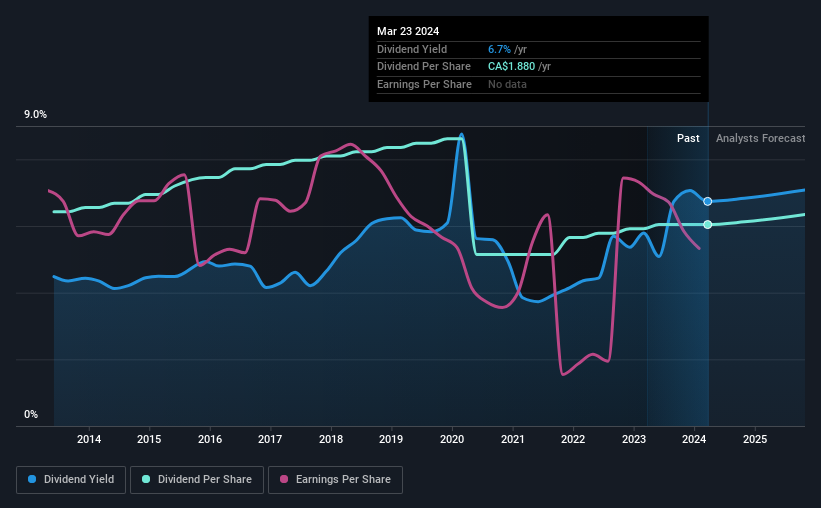Why It Might Not Make Sense To Buy Laurentian Bank of Canada (TSE:LB) For Its Upcoming Dividend

Regular readers will know that we love our dividends at Simply Wall St, which is why it's exciting to see Laurentian Bank of Canada (TSE:LB) is about to trade ex-dividend in the next 4 days. Typically, the ex-dividend date is one business day before the record date which is the date on which a company determines the shareholders eligible to receive a dividend. The ex-dividend date is of consequence because whenever a stock is bought or sold, the trade takes at least two business day to settle. Therefore, if you purchase Laurentian Bank of Canada's shares on or after the 28th of March, you won't be eligible to receive the dividend, when it is paid on the 1st of May.
The company's next dividend payment will be CA$0.47 per share, and in the last 12 months, the company paid a total of CA$1.88 per share. Based on the last year's worth of payments, Laurentian Bank of Canada has a trailing yield of 6.7% on the current stock price of CA$27.90. Dividends are a major contributor to investment returns for long term holders, but only if the dividend continues to be paid. That's why we should always check whether the dividend payments appear sustainable, and if the company is growing.
See our latest analysis for Laurentian Bank of Canada
Dividends are typically paid out of company income, so if a company pays out more than it earned, its dividend is usually at a higher risk of being cut. Laurentian Bank of Canada paid out 53% of its earnings to investors last year, a normal payout level for most businesses.
Companies that pay out less in dividends than they earn in profits generally have more sustainable dividends. The lower the payout ratio, the more wiggle room the business has before it could be forced to cut the dividend.
Click here to see the company's payout ratio, plus analyst estimates of its future dividends.

Have Earnings And Dividends Been Growing?
Companies with falling earnings are riskier for dividend shareholders. If earnings decline and the company is forced to cut its dividend, investors could watch the value of their investment go up in smoke. Readers will understand then, why we're concerned to see Laurentian Bank of Canada's earnings per share have dropped 7.1% a year over the past five years. When earnings per share fall, the maximum amount of dividends that can be paid also falls.
The main way most investors will assess a company's dividend prospects is by checking the historical rate of dividend growth. Laurentian Bank of Canada's dividend payments per share have declined at 0.6% per year on average over the past 10 years, which is uninspiring.
To Sum It Up
Is Laurentian Bank of Canada worth buying for its dividend? We're not overly enthused to see Laurentian Bank of Canada's earnings in retreat at the same time as the company is paying out more than half of its earnings as dividends to shareholders. Laurentian Bank of Canada doesn't appear to have a lot going for it, and we're not inclined to take a risk on owning it for the dividend.
Having said that, if you're looking at this stock without much concern for the dividend, you should still be familiar of the risks involved with Laurentian Bank of Canada. For example, we've found 1 warning sign for Laurentian Bank of Canada that we recommend you consider before investing in the business.
A common investing mistake is buying the first interesting stock you see. Here you can find a full list of high-yield dividend stocks.
New: AI Stock Screener & Alerts
Our new AI Stock Screener scans the market every day to uncover opportunities.
• Dividend Powerhouses (3%+ Yield)
• Undervalued Small Caps with Insider Buying
• High growth Tech and AI Companies
Or build your own from over 50 metrics.
Have feedback on this article? Concerned about the content? Get in touch with us directly. Alternatively, email editorial-team (at) simplywallst.com.
This article by Simply Wall St is general in nature. We provide commentary based on historical data and analyst forecasts only using an unbiased methodology and our articles are not intended to be financial advice. It does not constitute a recommendation to buy or sell any stock, and does not take account of your objectives, or your financial situation. We aim to bring you long-term focused analysis driven by fundamental data. Note that our analysis may not factor in the latest price-sensitive company announcements or qualitative material. Simply Wall St has no position in any stocks mentioned.
About TSX:LB
Laurentian Bank of Canada
Provides various financial services to personal, business, and institutional customers in Canada and the United States.
Good value with adequate balance sheet.
Market Insights
Community Narratives




